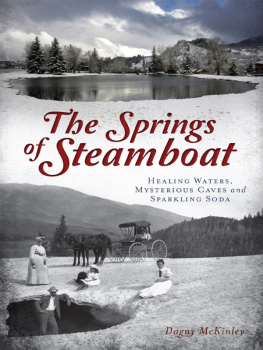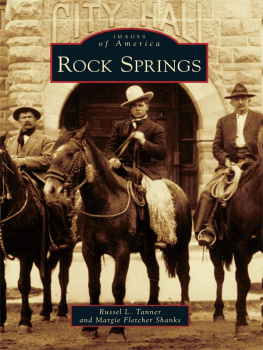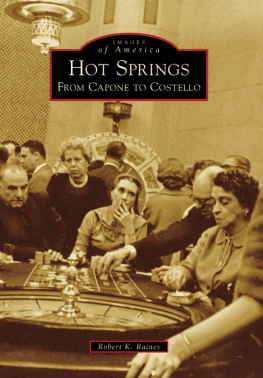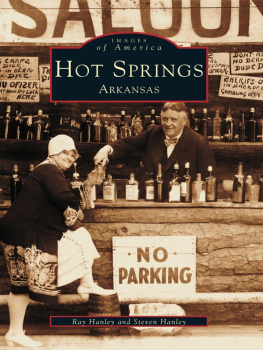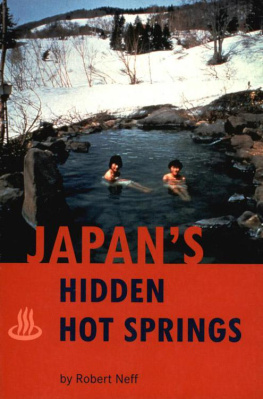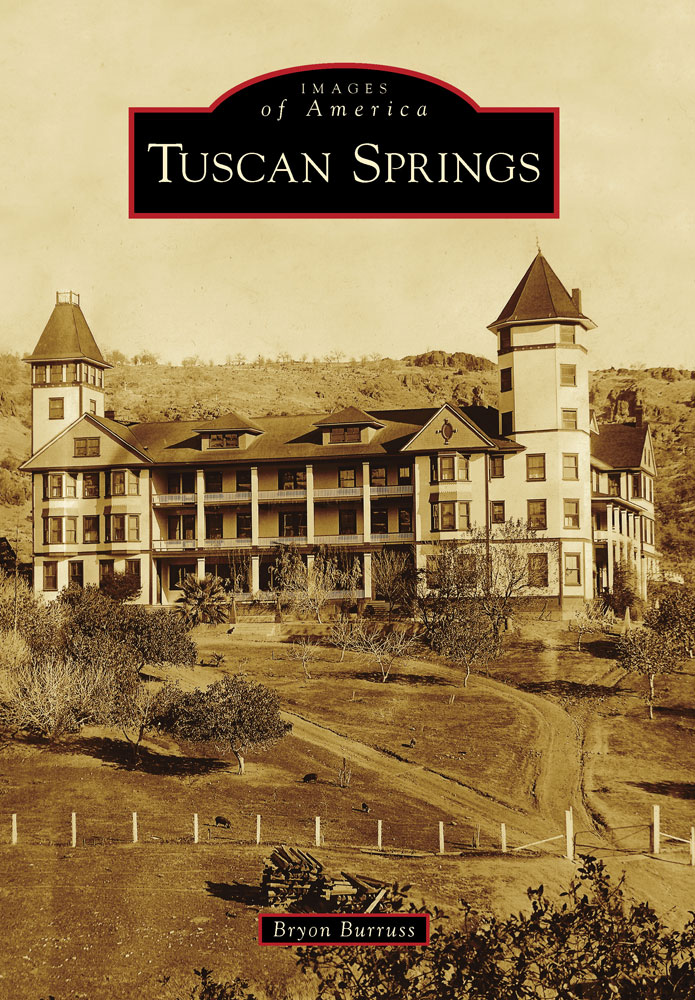
IMAGES
of America
TUSCAN SPRINGS

An 1882 survey map of Tehama County, California, shows the location of Tuscan Springs. Hidden in an extinct volcanic crater and surrounded by rocky buttes nine miles northeast of Red Bluff, the collection of mineral water springs was, if not the first, among the earliest hot springs resorts in the new state of California. The same year this survey was done, a massive downtown fire in Red Bluff destroyed many of the local businesses, including a shop owned and operated by Edgerton Byron Walbridge. A former telegraph operator from Iowa, Walbridge also lost his next business venture, a hotel, to fire in 1885, which led him to purchase the struggling Tuscan Springs resort in 1887. He constructed a magnificent Victorian hotel and steered the unique attraction to unprecedented heights of world-renowned success. (Courtesy Tehama County Library.)
ON THE COVER: In its heyday at the turn of the 20th century, the famous Tuscan Springs mineral water resort offered a grand three-story, 126-room hotel, complete with verandas all around, two kitchens, two dining rooms, parlors, and rooms for gambling. The resort also featured numerous cottages, stables, a saloon, steam and plunge baths, swimming pool, bowling alley, post office, ample hunting, and even a man-made lake, fully stocked with fish, ducks and sailboats. Its main attraction, though, was the more than 50 mineral water springs, each of which was said to cure numerous maladiesfrom cancer to the common cold. (Courtesy Tehama County Museum.)
IMAGES
of America
TUSCAN SPRINGS
Bryon Burruss

Copyright 2014 by Bryon Burruss
ISBN 978-1-4671-3122-3
Ebook ISBN 9781439642610
Published by Arcadia Publishing
Charleston, South Carolina
Library of Congress Control Number: 2013945928
For all general information, please contact Arcadia Publishing:
Telephone 843-853-2070
Fax 843-853-0044
E-mail
For customer service and orders:
Toll-Free 1-888-313-2665
Visit us on the Internet at www.arcadiapublishing.com
For Mom and Dad, with a lifetime of love.
This is yours.
CONTENTS
One of the greatest joys of living in rural Northern California is learning of the obscure and often fascinating histories of its hidden treasures. Typically, these tales are passed down through generations of local families, but details can be difficult to authenticate.
When it comes to the rise and fall of Tuscan Springs, Red Bluff author Bryon Burruss has done the legwork and offers here the most thorough account of the events that led to the development and eventual abandonment of Tehama Countys most unusual resource.
Beyond simply recounting the hard facts of Tuscan Springs, Burruss weaves together newspaper clippings, promotional materials, historical and societal context, and an abundance of photographs into a truly compelling story. The facts are there, but he has made the tale very readable.
One can only hope the author will apply his gift for storytelling to other North State yarns and preserve them for generations to come.
Chip Thompson
editor, Red Bluff Daily News
This book would not have been possible without the archives and helpful staff of the Tehama County Library, in particular, as well as the Tehama Museum, the Kelly-Griggs House Museum, and the Tehama County Genealogical & Historical Society. Each of them is severely underfunded and desperately in need of volunteers. Please consider offering your time to help them preserve the fascinating history of Northern California and encourage an interest in our heritage so that more books like this can be created before it all fades away.
I would especially like to thank Robert and Richard Neher, the current owners of Tuscan Springs, who have helped solve many mysteries over the years; Dan Masey for access to his collection and knowledge; Richard Burill, the author of numerous books on Ishi, for advice; Red Bluff Daily News editor Chip Thompson; Lamar Bayles and his photographic heritage; Red Bluff Fire Department history addict Larry Shnell; Arcadia acquisitions editor Jared Nelson for his knowledge and patience; and Joe H., without whom this book would never have happened.
Unless otherwise specified, images in this book are reprinted courtesy of the Tehama County Library. In most other cases, photographs are provided courtesy of the following: the authors collection (Author); Robert and Richard Neher (Neher); the Tehama County Museum (TCM); the Kelly-Griggs House Museum (KGHM); Dan Massie (Massie); Lamar Bayles (Bayles); the Meriam Library, California State University, Chico (CSUC); and Northern California Title Company (NCT).
What is the chief end of man?to get rich. In what way?dishonestly if we can; honestly if we must.
Mark Twain (18351910)
As the 20th century loomed ahead and railroad tracks stitched across the country like sutures on the wounds of the Industrial Revolution and the coming Civil War, a new and deadly epidemic was sweeping across the United States, leaving millions in its wake. Neurasthenia Americana caused varied and vague symptoms but was generally marked by chronic fatigue, sleeplessness, muscle pains, headaches, lack of motivation, and feelings of inadequacy. It was brought on, according to Dr. George M. Beard in the Boston Medical and Surgical Journal (1869), by such 19th-century developments as steam power, the periodic press, telegraph service, the sciences, and even the mental activity of women.
For relief, Americans turned to the hundreds of available patent medicines, homeopathy, phrenology, osteopathy, alcohol (and if that did not work, temperance), and even electrical shock treatments, but any relief was temporary at best.
Then, a small Northern California community stumbled upon a wondrous elixir that not only eradicated all traces of the dreaded new disease but also apparently cured every other illness known to man; it would also, incidentally, help put the fledgling city of Red Bluff on the map.
It is safely tucked in a long-extinct crater and tightly embraced by ragged, towering buttes. Sheltered from wind and weather, the hidden home of this magical potion might as well have been torn from the pages of a fairy tale. Set against a backdrop of oak, pine, and polished lava amid the contented trill of birds and the aroma of rich earth, saltwater, and wild herbsfar from the city lights, its evening stars smolder like sapphire embers.
It is only a casual horse trot northeast of Red Bluff, yet the purveyors of its liquid miracle would find scandal, heartbreak, and ruin on the road to Tuscan Springs.
The story of this famous health resort is the story of Red Bluff, which is the story of California; one tale cannot be fully told without the others, and they all begin with an accident near Sacramento in 1848.
The discovery of gold at Sutters Mill began the largest mass movement of people since the Crusades as crazed settlers crowded into the virgin territory, bringing with them the new philosophy that no obstacle can possibly stand in the face of providence and a little bit of luckor at least the right pickaxe.
John A. Sutter saw it all coming.
He predicted the inevitable land boom and its need for lumber and began harvesting timber, envisioning himself as baron of a West Coast lumber empire. Undeterred by the Mexican-American War, which raged between 1846 and 1848, and the fact that California was not even American property, Sutter commissioned James W. Marshall to build a water-powered sawmill in Coloma. His plans were progressing exactly as anticipated until Marshall found flakes of gold in the mills tailrace. Sutter tried desperately to keep the discovery a secret for fear that it would ruin all his plans, but there was no stopping the news, and settlers soon flooded in from all over the world in a rabid race for riches.
Next page


